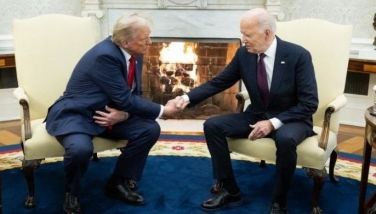SC members must elect their own CJ?

SC MEMBERS: President Noynoy Aquino has appointed Ma. Lourdes P. A. Sereno as Chief Justice. But it is still valid to ask if the correct procedure is for the members of the Supreme Court to elect their own Chief from among themselves.
The thought-provoking point is raised by Alan F. Paguia, Constitutional Law professor at the Pamantasan ng Lungsod ng Maynila and Chief Justice Claudio Teehankee Professorial Chair in Constitutional Law and Human Rights at the Ateneo Law School.
Paguia starts by asking: “Does the phrase ‘Members of the SC’ necessarily include the Chief Justice?” His answer is No.
* * *
AMONG EQUALS: This is Paguia’s line of reasoning, quoted directly but edited to fit space:
“While it is true that the Chief Justice is necessarily a Member of the Court, it is equally true that a Member of the Court is not necessarily the Chief Justice.
“The appointing power of the President vis-à-vis the Supreme Court is categorically LIMITED to the MEMBERS.
“There are 15 MEMBERS who may sit altogether en banc or in divisions of 3, 5, or 7 members. One of the 15 is designated as Chief Justice and the rest are designated as Associate Justices.
“The Chief, as leader, is not necessarily superior to the Associates. Such leadership is dictated by the logical requirements of administrative order and convenience in collegial bodies. Thus, he is known as primus inter pares, or first among equals.
“When a MEMBER — whether Chief or Associate Justice — dies, retires, resigns, is permanently incapacitated, or is removed by conviction in a valid impeachment proceeding, a vacancy arises in the 15-MEMBER Court.”
* * *
RULE NOT CLEAR: “The Constitution says that the ‘Members of the Supreme Court (and judges of lower courts) shall be appointed by the President.’
“When Chief Justice Renato C. Corona was removed through impeachment proceedings, he vacated two positions – as (a) Member, and as (b) Chief Justice.
“With respect to the vacancy pertaining to the position of Member, it is clear that the same shall be filled by the appointee of the President. (Sec. 9, ART. VIII)
“With respect to the vacancy pertaining to the position of Chief Justice, it is NOT CLEAR whether the same shall be filled by the appointee of the President. The Constitution is silent as to how such vacancy shall be filled.
“The rule is: Where the law is not clear, it must be construed and applied accordingly.”
* * *
INDEPENDENCE: “Considering that the position of Chief Justice refers to the leadership of a co-equal branch of the tripartite system of government, it follows that a reasonable construction must observe the principle of separation of powers among the legislative, executive, and judicial branches.
“Their institutional independence with respect to one another must be maintained to keep the principle of checks and balance alive and effective.
“Observe how the Constitution determines the leadership of the two Houses of Congress – the Senate and the House of Representatives. The first has the Senate President; the second has the Speaker of the House.
“These two leaders are: (a) not appointees of the Chief Executive; (b) elected by their colleagues from among themselves; (c) chosen to strengthen their respective institutional independence.
“It would not seem reasonable to have the leadership of the Supreme Court determined differently.
“The logic of the Constitution would appear to indicate that the Chief Justice must: (a) not be an appointee of the President; (b) be elected by the 15 Magistrates from among themselves; (c) be chosen to strengthen the High Court’s institutional independence; (d) not be subject to any sense of political debt of gratitude.”
* * *
CONSISTENCY: “May tradition be properly invoked to justify the presidential, albeit unconstitutional, practice of appointing the Chief Justice?
“NO. The Constitution and the laws are repealed only by subsequent ones, and their violation or non-observance shall not be excused by disuse, or custom or practice to the contrary. (Art. 7, Civil Code)
“Even the Magistrates of the Supreme Court seem inclined to take the view that the Chief Justice ought to be elected from among themselves.
“If they truly believe it is the President who has the authority to appoint the Chief Justice, they should have — to be consistent — asked the President to appoint the Acting Chief Justice to fill up in the meantime the vacancy created by the removal of Chief Justice Corona.
“They did not. Instead, they elected from among themselves Associate Justice Antonio Carpio as such Acting Chief Justice. And President Aquino did not object.
“Conclusion: President Aquino’s appointment of Chief Justice Sereno appears shadowed by a dark constitutional cloud of doubt as to its validity.”
* * *
LGU MATTERS: President Aquino needs as secretary of the Department of the Interior and Local Government somebody long immersed in the dynamics of local governance, not someone going out to round up provincial politicians into the administration party’s national network.
But the President has already nominated Liberal Party President Mar Roxas as DILG secretary and, it seems, that’s it.
The DILG needs somebody in the mold of multi-awarded San Fernando City Mayor Oscar Samson Rodriguez, president of the League of Cities of the Philippines, and acting president of the Union of Local Authorities of the Philippines that has as members the federation of local elective officials and the league of local government units (governors, vice governors, municipal mayors, city mayors, vice mayors, councilors, barangay officials and Sangguniang Kabataan leaders).
* * *
RESEARCH: Past POSTSCRIPTs can be accessed at manilamail.com. Follow us via Twitter.com/@FDPascual. Send feedback to [email protected]
- Latest
- Trending
































